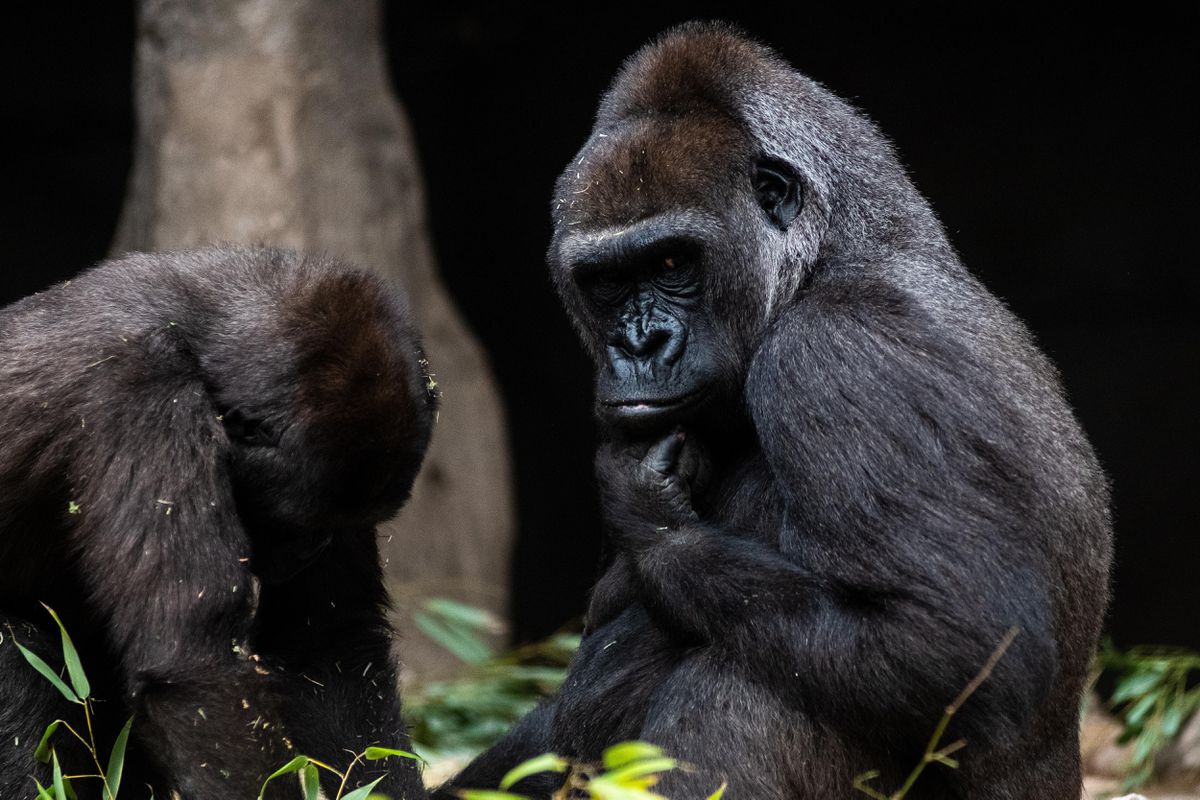
Marcos del Mazo/LightRocket via Getty Images
Virologist Dave Wessner explores what a gorilla having a case of Covid-19 tells us about the spread of the virus from humans to animals, and vice-versa.
Recently, veterinarians from the San Diego Zoo Safari Park confirmed that gorillas at their facility had been infected with SARS-CoV-2, the novel coronavirus that causes Covid-19. Obviously, this development is concerning. Already endangered, gorilla populations could be further threatened by this new pathogen. Evidence of this virus in non-human primates also raises fundamental questions about the transmission of viruses between species and the evolution of pathogens.
Most viruses exhibit a fairly limited host range; a given virus only infects one or maybe a few different species. However, the transmission of viruses from their primary host to a secondary host may happen quite frequently. The results of these “spillover events” can differ dramatically.
Transmission from animals to humans can lead to the evolution of a new virus
In some cases, the transmission of a virus from an animal to a human, known as a zoonotic transmission, may lead to the evolution of a virus well-adapted to its new host. For an example, let’s look at HIV. First identified in 1983, this virus probably has been infecting, and adapting to, humans since the early 20th century. Molecular analyses show that it is closely related to a simian immunodeficiency virus known as SIVcpz that infects a specific species of chimpanzee, Pan troglodytes troglodytes. Presumably, the virus was transmitted from an infected chimp to a person, possibly while humans were hunting. The virus replicated and mutated within this new-found host and then spread to another person. Additional mutations allowed the virus to replicate more efficiently and be transmitted more effectively. The result? According to UNAIDS, about 38 million people currently are living with HIV and roughly 33 million people have died of AIDS-related illnesses.
The full story of HIV and zoonotic transfers, however, is even more complex. A vast majority of HIV infections in humans result from one particular form of the virus, HIV-1 group M. But some infections are caused by HIV-1 group N, group O, or group P viruses. Another, more distantly-related virus, HIV-2, also infects some people. Researchers believe that these human viruses all resulted from separate zoonotic events. Indeed, researchers have shown compelling evidence that the HIV-1 group O virus, which has infected roughly 100,000 people primarily in western Africa, is closely related to SIVgor, a virus known to infect gorillas, and probably arose from a zoonotic transfer from gorillas to humans. Bottom line? HIV-like viruses have been transmitted from non-human primates to humans repeatedly. In one case, this zoonotic transfer resulted in a global epidemic.
Other human pathogens have followed a similar path. Today, measles virus infects humans exclusively. But, like HIV, it almost certainly arose via a zoonotic transfer. Molecular techniques show that measles virus is related to rinderpest virus, a now-eradicated pathogen of cattle. Most likely, a form of rinderpest virus was transmitted from cattle to humans, adapted to its new host, and became today’s human pathogen. Unlike the HIV story, though, this transition occurred in the distant past. Current estimates indicate that measles virus emerged roughly 2500 years ago.
Many zoonotic transmissions are “dead ends” and don’t lead to epidemics
More often, though, animal-to-human transmission doesn’t lead to the evolution of a major human pathogen. Rather, humans prove to be dead-end hosts. The virus may cause severe disease in its accidental host, but human-to-human transmission occurs inefficiently. The result? A relatively small outbreak may ensue, but not a pandemic. A strain of avian influenza virus known as H5N1 presents a good example. This virus can be transmitted easily among birds and domesticated poultry. When transmitted to humans, the virus is deadly, exhibiting a case fatality rate of 60%. But human-to-human transmission is very rare.
Middle East respiratory syndrome, or MERS, presents another example. This disease, caused by the coronavirus MERS-CoV, first was reported in 2012. Most likely, the virus is transmitted to humans from dromedary camels, although bats probably are the primary reservoir for this virus. Even though the case fatality rate in humans is quite high, human-to-human transmission is rare. Consequently, less that 3,000 cases of MERS have been documented in the decade since it was first categorized.
Reverse zoonotic transmissions from humans to animals can occur
Not surprisingly, viruses also can be transmitted from humans to other animals. Sometimes referred to as reverse zoonoses, these spillover events mirror the dynamics of animal-to-human transmissions. The virus may adapt to its new host and spread from animal to animal, or the animal may be a dead-end host. The biggest difference between zoonoses and reverse zoonoses? We are much less likely to observe these reverse zoonotic events. Think about it. If a novel virus is transmitted to a human and causes severe disease, healthcare providers will take note. If a virus is transmitted from a human to an animal, will it be noticed? Probably not.
Why zoonotic transmission matters: SARS-CoV-2 originated in bats
The natural reservoir for SARS-CoV-2, like the coronavirus MERS-CoV, is bats. Unlike MERS-CoV, however, this virus can be transmitted from person to person quite easily. And, it appears, it can be transmitted from people to other animals. According to the U.S. Department of Agriculture, SARS-CoV-2 infections in the United States have been confirmed not only in gorillas, but also in cats, dogs, minks, tigers, lions, and snow leopards. In all cases, it is assumed that the animals contracted the virus after coming in contact with an infected human. The impact of the virus on these species remains to be seen. But the transmission of this novel coronavirus from bats to humans to gorillas and other animals does shed light on the complex process of viral evolution and confirms the importance of robust emerging infectious disease surveillance programs.
Full coverage and live updates on the Coronavirus
This article is auto-generated by Algorithm Source: www.forbes.com


